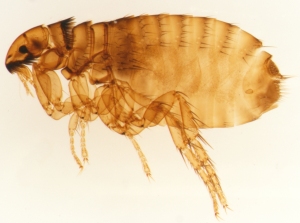Cat Flea, Human Flea
 Scientific Name
Scientific Name
Ctenocephalides felis, Pulex irritans
Habitat
A wide variety of animals, including humans.
Life Cycle
Flea eggs are small and white. Generally, after several weeks the eggs drop off and hatch into tiny, hairy, worm-like larvae. The larvae are usually found where the animal sleeps, along baseboards, in carpets, or on furniture. Pupa mature to adulthood within a cocoon woven by the larva to which dust, pet hair, carpet fibers, and other debris adhere. After about five to fourteen days adult fleas emerge from the cocoon. Female fleas lay up to twenty eggs per day and six-hundred in a lifetime. Although fleas can live up to two months or one year without eating, they cannot survive or lay eggs without blood. Newly emerged adult fleas live only about one week if a blood meal is not obtained. People may be bitten by fleas, especially when populations are high, but fleas will not live and reproduce on humans.
Description
About 1/16 to 1/8 inch long; small wingless insects; pale to dark reddish brown with a laterally flattened body with numerous backward spines and bristles to aid sticking to the fur. Claws at the tips of the legs also enable the flee to stay attached to the fur even when the animal shakes or scratches vigorously. Long legs allow the insect to make lateral jumps of up to 14 to 16 inches.
Control
Please contact your local county extension office for current information.
